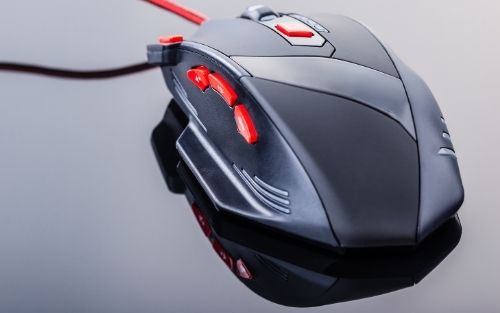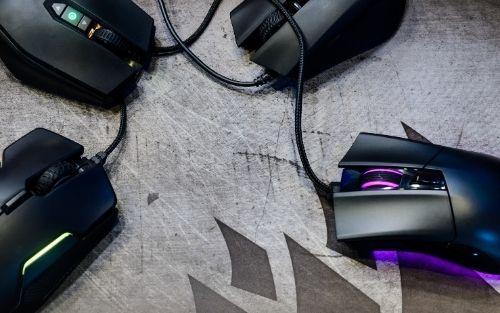Table of Contents
Are you planning on buying a new computer mouse? I’ve been there and I’ve done it more than a dozen times.
I want to show you everything I know about computer mice.
Here is every consideration I think you need to know before you make a purchase for the best computer mouse for your needs.
I’ve dropped down about 8 steps to consider when you are looking to buy a computer mouse.
Let’s get started.
Sometimes, when we’re thinking about the best ways to improve and upgrade our computers, we most likely don’t think about our mouse. This is totally fine, it’s a small part of the user experience, right?
Well, not true. A mouse has a lot to do with the experience we have using a computer.
In fact, it’s one of the most used pieces of hardware on your computer.
Take my advice and don’t settle with a cheap piece of junk that you’ll end up regretting for years to come.
The use of a mouse is sometimes vital to our workflow. Finding a good one helps us not only in productivity but also prevents injury in our wrists and fingers.
Step 1. Choose a mouse that suits your needs
For the majority of everyone out there, the standard mouse will do. These are usually the three-button mouse. One on the left, one on the right, and a scroll wheel that doubles up as a middle button as well.
This will probably do the job for most people.
However, if you’re not just most people, you might want to consider a more specialty-designed mouse instead.
Gaming mice are meant for users who want options
If you are a gamer, then you should always invest in a dedicated gaming mouse. It doesn’t necessarily make you a better player, but it will make your actions a whole lot easier.

These gaming mice usually have more buttons, higher sensitivity to movement, better ergonomics, and improved accuracy.
Gaming mice also offer better ergonomic benefits, making them more comfortable when using the mouse for long periods of time.
With an exhaustive amount of buttons directly on your fingertips, you can configure how the mouse works and plays.
Gamers usually require a lot of buttons.
With a gaming mouse, you can reconfigure a button to pull out your rifle, or your medical kit.
You can also create a lot of complicated single button actions that web out into other actions within a game.
A lot of gaming mice have the ability to switch DPIs on the fly. The higher the DPI setting the faster the cursor speed. However, the lower the DPI setting the smoother and more accurate the mouse will become.
Travel mice are made for small and for mobility
Another specialized type of mouse that is commonly seen out in the open, is the travel mouse.
These travel mice aren’t fancy or made to look cool.
Most of them are two to three-button devices and are shrunken into tiny little mini-sized mice that have a benefit for travel.
You’ll find that most of these travel mice come as wireless mice. However, some older versions can have retractable cables.
A travel mouse works great for people who are always on the go. These are people who are always carrying laptop bags, or purses, and are always traveling. These travel mice are small and compact.
Unfortunately, being small and compact oftentimes means that they can become very uncomfortable to use for a long period of time. But if you don’t want to carry around something as large as a life-size rat, then these tiny little mice are the mice for you.
They aren’t meant for heavy use.
Step 2. Think about the ergonomics of a mouse
When we talk about ergonomics, what we’re really thinking about is how well the mouse fits in your hand. This can be an important factor in preventing injury.
By using a mouse that fits naturally under the palm of your hand, and doesn’t cause your fingers to strain, will allow you to comfortably use the mouse for much longer periods of time.
You must also think about the buttons that come with the mouse. Are they close enough to your fingers where you don’t have to reach?
Comfort is a very subjective topic, but generally speaking some users like their mouse to be flat, while other users like to grip their mouse around as if they were holding a ball.
It’s important to also consider the size of the mouse when it comes to comfort.
Unfortunately for people who are left-handed, the selections may be much fewer than those who are right-handed.
There are these mice that have this vertical grip. They are specialty mice where the palm of your hand is not actually facing the table but turned to the side. A lot of people believe that this is a much more natural state of how your hand and wrist should be.
Another factor of ergonomics is the noise. People who often use their mouse might notice how’s the button clicks are really loud. Even if it doesn’t annoy you, it might annoy the person close by.
Some companies have developed silent clicking mice which are actually much easier to click on.
Step 3. Don’t worry about higher DPI
One main specification when you have looked thoroughly into buying a mouse is the DPI. DPI stands for dots per inch.
It is a measurement of how far a mouse pointer will travel on your screen based on how far you are moving the mouse with your hand.
Let’s say you have a mouse that has 400 DPI. This would mean that if you used it on a display with 4000 pixels wide, you would have to drag the mouse exactly 10 in across your display to get from one side to the other.
Unfortunately, this does have its drawbacks. Higher numbers aren’t always better in this case. with faster mouse pointers, you begin to lose accuracy.
I highly recommend that for normal users, don’t worry about the DPI. But for gamers, a higher DPI allows you to move and react more quickly. Most gaming mice will allow you to adjust DPI from high to low.
If you are using your computer for things like photoshop or editing small little things, then it would be more of a benefit for you to look for a mouse that is capable of lower DPI. This will allow you to move your mouse with even higher precision.
Step 4. Don’t focus on hertz rate
Another key aspect of a computer mouse is what is known as the polling rate. This is actually a measure in hertz that shows how many times each second that the mouse relays its position to the computer.
If the mouse has a high polling rate, it means that this mouse has better accuracy and smoother movement.
For an average user, you could put a high polling rate mouse and a low polling rate mouse side by side and you probably won’t notice the difference when using both.
This is really more of a professional gamers figure.
I don’t recommend anyone to consider this spec only because it is debatable whether even anyone can see or feel the difference.
Step 5. Which is better optical or laser?
There are two different types of mice technologies that are highly marketed. One is called an optical mouse and the other is called a laser mouse.
An optical mouse uses an LED while a laser mouse uses a laser to track movement.
The advantage is that a laser mouse does not need to be used on top of opaque surfaces compared to an optical mouse. In fact, you can use a laser mouse on glass.
Laser mice are also more sensitive, and they could reach higher DPIs.
There is one issue with the higher DPI ratings in a laser mouse. It can result in a dilemma called “acceleration.” This is a nightmare for gamers, because the mouse pointer may travel further if you move the mouse really quickly compared to moving it slowly.
Step 6. Wireless mice have improved a great deal
I can honestly say that wireless mice have truly caught up with wired mice when it comes to lag.
Normal users won’t be able to tell the difference between the latency of a wireless versus a wired mouse.
However, one thing you’re going to have to keep in mind is that a wired mouse may not always be reliable since it is running on a battery.
Having a wireless mouse is oftentimes convenient because of getting rid of the wire that holds it back.
It also helps declutter the workspace.
Step 7. Bluetooth is better for wireless mice
Now, there are actually two types of wireless mice to consider. One uses radio frequency and the other uses Bluetooth.
You can tell that a mouse uses radiofrequency if it has a tiny dongle that connects to your computer. Bluetooth mice simply connect to your computer via Bluetooth which is already integrated into most computing devices anyway. Bluetooth doesn’t take up any extra USB space from your computer.
Step 8. Mouse verse trackpad
If you still can’t decide on which mouse you would like to purchase, how about try using a trackpad? I’m referring to the trackpads that are similar to what you’ll find on a laptop.
Now, these are not good for gaming and things like photo editing, but some users might find it easier to get used to when it comes to just touching and moving your mouse with your finger.
Our recommended mice
Check out my page on the best computer mouse I could find. This list comes from a combination of all the best recommendations I could find along with my own opinions on which mouse is best.
More related content:
